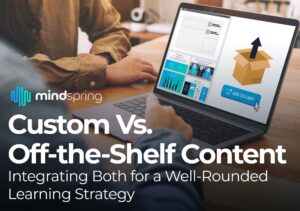Instructional design is a word that can have a variety of meanings depending on your background. Or perhaps, no meaning at all. So we often get asked, “What is it that we actually do?” For this post, we’ve asked one of our instructional designers to explain what it is that we do.
Family and friends know I work many days from my office and most days can be found working at my computer. They know I have an education background and that I have a love for curriculum and students but they do not know what I do on a daily basis. To be truthful, I struggle with how to answer them. I have told them I am an instructional designer and that often causes a blank stare and followed by, “Oh, but what do you DO?”
In an effort to easily answer that question, I have come up with a few quick points to explain what an instructional designer does:
1) An instructional designer designs learning materials using best practices.
I spend a lot of time looking at theories and materials and combining them to create a rich learning experience. I want to be sure that the content being delivered to the client is delivered in the best way possible. For example, if a company needs to deliver safety instruction to its employees, I want to make sure that the needed safety content is delivered in a way that is interesting, engaging and at an appropriate intellectual skill level. This design can actually take a lot of forms because our clients can range from kindergarten teachers, to adults going back to school, or manufacturing companies, other corporations and even non-profits. You might see me designing an activity with Legos or working on training that supports a very technical proprietary process for a car headrest and everything in between.
2) An instructional designer develops materials that use best practices
Development of materials is something I spend a good deal of time on. I use design principles to develop materials that help the learner best retain what they just studied, are interactive and built on what we know about brain research and learning. I get to use technology to produce high quality learning objects. Time is spent choosing the best tool to develop the materials and then checks are put into place to be sure the learning objectives are being reached. It is important to me to create with the learner in mind and to be sure I am adding to their knowledge by the materials I create. What this really means is that I get to play with a lot of cool digital tools. On a weekly basis our team uses everything from Articulate Storyline, to infographic software, video editing tools, and animation software. It’s one of the best parts of the job and we’re kind of nerdy about it.
3) An instructional designer delivers the materials to the client.
In many ways this is the icing on the cake for myself and other designers. It allows us the opportunity to interact with the students or follow up with clients to be sure the material is meeting their needs and objectives. Sometimes this includes facilitating a course online, sometimes this means follow-up/mentoring within schools working with teachers and students. It can also mean building a long-term relationship with a corporate client to help them better serve the employees they provide training to. We work in a lot of different worlds so delivery can take many forms.
There are many other things an instructional designer can and does do as well, but these three points help me quickly explain to others how I spend my days!—Becci Zwiers
Check back later to our blog to hear other perspectives.









